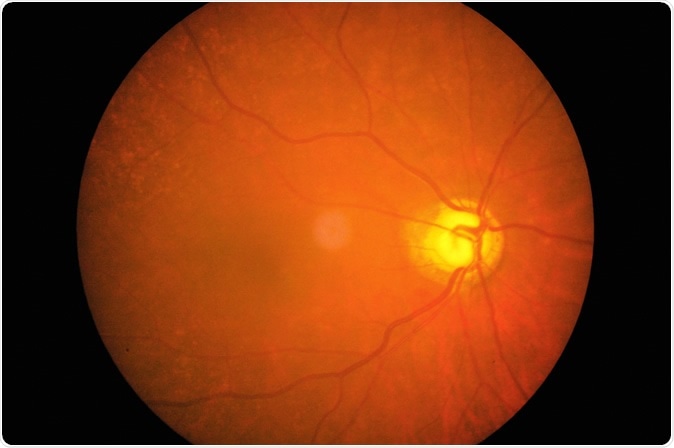The long-term use of statins, drugs that control elevated cholesterol levels, has been linked to a lower risk of developing glaucoma, a new study suggests.
The study, which was published in JAMA Ophthalmology, brings the link between statin and risk of glaucoma into sharper focus. The researchers at Brigham and Women’s Hospital have found that taking statins for five or more years is associated with a lower risk of developing primary open-angle glaucoma (POAG).
Past research has suggested that statins also lower intraocular pressure and promote circulation to the optic nerve. Now, the new study provides long-term data. The team of researchers followed and gathered information from 136,782 patients aged 40 years old and above for about 15 years.
The researchers recruited the patients from the Nurses’ Health Survey (NHS) from 2000 to 2014, the NHS2 between 1999 and 2015, and the Health Professionals Follow-up Study (HPFS) from 2000 to 2014.

Retinal image of left eye in a 76 years old woman with glaucoma. Image Credit: Santibhavank P / Shutterstock
Lower risk of glaucoma in statin users
The researchers took into consideration the use of statins and incidence of glaucoma. They collected self-reported data on the respondent’s statin use and serum cholesterol levels. The results of the study showed that using statins for five years old and above is linked to a 21 percent lower risk of developing open-angle glaucoma.
Furthermore, the researchers found that increasing levels of cholesterol also surges the risk of glaucoma. Patients with any history of elevated cholesterol were 17 percent more likely to have glaucoma. In fact, every 20 mg/dL rise in total serum cholesterol levels in the blood is related to a 7-percent increase in primary open-angle glaucoma risk.
“Our study suggests possible protective associations beyond cardiovascular conditions for long-term statin use. Statins may also strengthen neuroprotective mechanisms that prevent degeneration of cells in the optic nerve," Jae Hee Kang, the assistant professor of medicine in the Channing Division of Network Medicine, said in a statement.
Future research is still needed
However, the researchers pointed out that the study relied on self-reported statin use and cholesterol levels. Also, they said that future studies may increase the coverage, sampling more diverse populations.
Also, the researchers reiterated that the findings of the study don’t mean that people with a family history of glaucoma should take statins or other drugs that lower cholesterol levels. It’s important to conduct further studies and clinical trials to determine if there is a connection between the use of statins and glaucoma prevention.
“Our study doesn’t address whether statins stop the progress of the disease. That would require a clinical trial,” Kang said, emphasizing that a high risk of developing glaucoma isn’t a reason to start statins, further studies are still needed.
“As high cholesterol and statin use have been associated with other neurodegenerative diseases, the interrelationships between cholesterol, glaucoma and these outcomes is also fertile ground for further scientific inquiry,” Kang added.
What is glaucoma?
A glaucoma is a group of diseases that damage the optic nerve, which results in blindness.
About 3 million Americans have glaucoma, the Centers for Disease Control and Prevention (CDC) reports. Glaucoma is the leading cause of vision loss across the globe. In 2013, about 64.3 million people have glaucoma worldwide, and the number is projected to increase to a staggering 76 million in 2020, and 111.8 million by 2040.
Primary open angle glaucoma is the most common type of glaucoma and it happens because of blockage in the eye’s drainage canals. As a result, the intraocular pressure increases since the right amount of fluid can’t go out of the eye.
Though many people with this type of glaucoma are symptom-free, late diagnosis can ultimately lead to vision loss and blindness. POAG progresses slowly and in some cases, without noticeable vision loss for many years.
The common signs and symptoms of glaucoma include a slight loss of peripheral vision and difficulty of adjusting to low light. But, since there is no accompanying pain or discomfort, about 50 percent of people with glaucoma don’t know they have it. The lack of symptoms makes early detection hard, and by the time they are diagnosed, it’s too late to prevent vision loss.
Journal reference:
Kang, J., Boumenna, T., and Stein, J. (2019). Association of Statin Use and High Serum Cholesterol Levels With Risk of Primary Open-Angle Glaucoma. JAMA Ophthalmology. https://jamanetwork.com/journals/jamaophthalmology/article-abstract/2732293